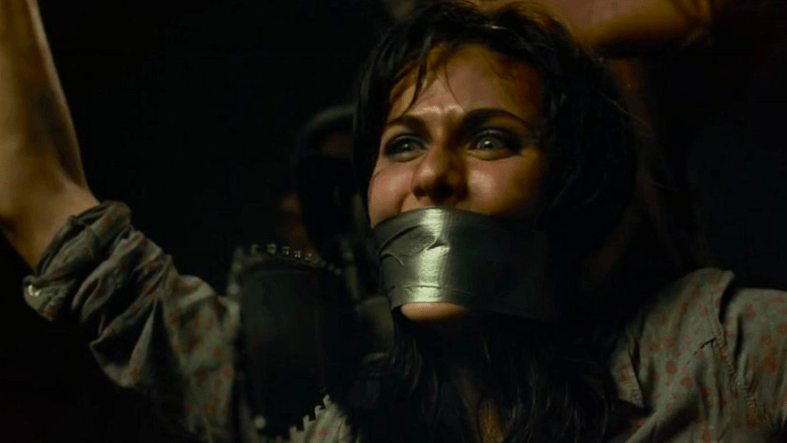‘Texas Chainsaw 3D’ is a Rip-Roaring Bad Time

Texas Chainsaw 3D is a bad movie. There’s a contemporary trend of elevating bad movies to good art, an insistence that enjoying something is akin to that something being good. Broadly, I fear it’s eroded the politics of bad taste. I’m proud of the bad things I like. I even had a column on rotten movies I regularly enjoyed. There’s nothing wrong with liking something while simultaneously conceding that it’s not very good. Texas Chainsaw 3D, released this day in 2013, is one such example.
Broadly, I understand what director John Luessenhop and writers Adam Marcus, Debra Sullivan, and Kirsten Elms were trying to accomplish with Texas Chainsaw 3D. For the uninitiated, the Texas Chainsaw (or Chain Saw if you’re a purist) mythology is equal parts dense and whacky. It doesn’t make a whole lot of sense, and entries subsequent to the first, including Texas Chainsaw Massacre: The Next Generation (also known as The Return of the Texas Chainsaw Massacre, a better title) and The Texas Chainsaw Massacre: The Beginning were content to liberally play around with the Leatherface lore, retrofitting him into both parodic and grimly self-serious slashers. That, of course, says nothing of the confounding prequel Leatherface, released in 2017, or 2022’s Texas Chainsaw Massacre.
Also Read: The Power Of Showing Skin in ‘The Texas Chainsaw Massacre 2’ [FINAL GIRL FASHION]
If nothing else, it’s been a wildly inconsistent series. Though for a slasher franchise, that isn’t necessarily unfamiliar territory. Most of the greats, Ghostface possibly being the only exception, carry with them marred legacies, sequel after sequel that reduced iconographic villains into nothing but caricatures. In Texas Chainsaw 3D, believe me when I say Leatherface is a joke.
The broad structure sees local vigilantes and law enforcement siege the Sawyer home Rob Zombie-style after the events of the first movie. As a result, several family members are killed, though one child miraculously survives, being handed off to another family to raise as their own. That child grows up to be Alexandra Daddario’s Heather. When she’s notified of her adoption, she loads her contentious friends into a van for some good old-fashioned Texas trekking.
Of course, arriving at a home bequeathed to her, she’s surprised to find a hulking maniac with a predilection for power tools living in the basement. He kills all of her friends in decent R-rated fashion, though compared to prior entries, the violence is considerably tamer, the effects less suggestive. A bunch else happens, including some run-ins with local law enforcement and enforcers (and hunks, in the case of Scott Eastwood’s Deputy Carl). Basically, Heather and Leatherface become a sort of dynamic duo. Heather regresses into her lineage nicely, teaming up with her cousin for some familial revenge. Everyone remembers her third-act chainsaw kick, punctuated with “Do your thing, Cuz.”
Also Read: Meat Hanging and Head Banging in ‘The Texas Chainsaw Massacre Part 2’ [Spins and Needles]
Narratively, Texas Chainsaw 3D is a mess. To work from the top down, Heather’s arc from victim to villain is thematically suspect. Not mere moments before her change of heart, Heather herself was screaming Marilyn Burns style, fleeing from Leatherface as he chased her into a coffin, through the woods, and even—in the movie’s single-inspired beat—through a local carnival. That she would arbitrarily change sides makes no sense, though it’s compounded by the implication of Sheriff Hooper (Thom Barry), a man who, for some reason, opts to let Heather and Leatherface go free.
Now, for a reminder of context. Moments before law enforcement endeavors to bait and kill Leatherface for good, he’s mercilessly slaughtered all of Heather’s friends, her boyfriend, and even another police officer. He might be family, but it’s a decidedly singular feeling.
To narrow a bit more, the writers introduce an infidelity subplot (Trey Songz is cheating on Heather, oh no), a cheap but at least plausible explanation for Heather’s change in attitude. Only, Heather never once learns of the affair. Not at all. It’s there for the audience and… no one else? Why?
And, of course, the 3D elements are shoehorned in, more akin to Friday the 13th: Part III than, say, something like Avatar (or even Final Destination 5 admittedly). It never adds depth or texture, illumination, or expansion. It’s just things flying at the screen, a chainsaw sort of ripping through the audience that can stomach 3D glasses (which is not me).
Also Read: Rev It Up: Five Movies to Watch After ‘Texas Chainsaw Massacre’
It’s bad, and I thought it was bad when it was released. It’s not scary, it’s never intentionally funny, and the deaths aren’t even grisly enough to warrant at least a passing interest. Plus, it followed two of the strongest entries in the entire series (I’m a The Beginning stan, fight me), so it feels even worse by comparison. Yet, I saw it not once, not twice, but three times in theaters. Of my own volition. For some reason, I couldn’t get enough.
Texas Chainsaw 3D was a beguiling travesty. It wasn’t good, yet I paradoxically both loved and loathed it. I loathed its total disregard for filmic convention and narrative coherence, for its failure to deliver the bare minimum of what a horror movie should be. But I loved it all the same for those exact same reasons.
Anyone who knows movies knows that this didn’t just happen. A lot of people were involved at every stage—and maybe that was the problem. Ultimately, a swarm of talented craftsmen and creatives ended up releasing this. That’s fascinating to me, and the longer Texas Chainsaw 3D sits with me, the more it grows on me. I appreciate how it lacks the nihilism of the prequel Leatherface or the tone-deaf politics of the most recent entry. It’s a silly, goofy movie for when I’m in a silly, goofy mood. And, well, I kind of love it for that. Do your thing, Cuz—I’ll be there to watch it.
Categorized:Editorials

